Every James Cameron Movie Ranked from Worst to Best
James Cameron hasn’t made a lot of movies, but nearly every one has been a major cinematic event. From Aliens to Terminator 2 to Avatar, which is the best?
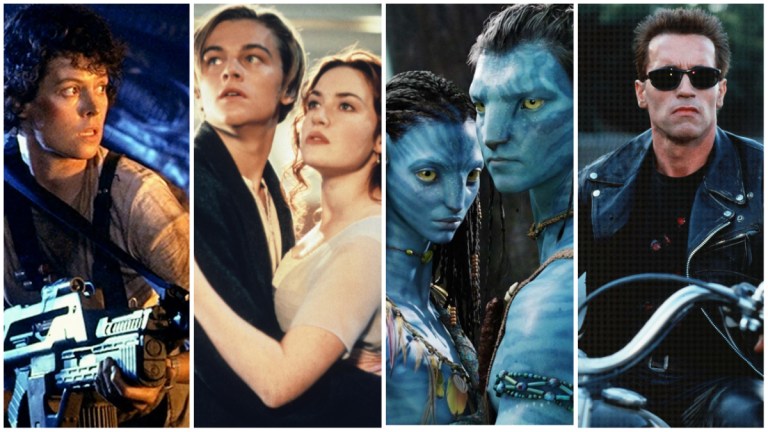
“Never bet against James Cameron” has been the conventional wisdom in the film industry, and the adjacent world of film criticism, for at least 25 years. It started roughly around 1997 when Titanic was delayed by six months and its budget ballooned to massive proportions. A vanity project from an auteur director with a runaway budget? It was immediately prophesied to become a box office catastrophe that could sink two major studios.
Instead it went on to become the biggest box office success of all time, a title it held for 12 years until it was defeated by… Avatar, another Cameron movie that was expected to tank and instead scaled to almost unparalleled financial heights. Titanic also won 11 Oscars, tying it for the most ever, including Best Picture and Best Director. From that point on, the idea that the man’s seemingly uncanny commercial and creative instincts, as well as his truly visionary approach to epic filmmaking, took hold in the pop culture zeitgeist and has remained there ever since.
What makes this a little odd, however, is that after 40 years of filmmaking—his first official directorial effort, Piranha II: The Spawning, came out in 1982—Cameron has made just nine feature films, even as he’s produced or supervised others, as well as helming documentaries, TV movies, and pilots. But with the exception of his debut, nearly every single one of his movies has been a game-changer of some kind, either on a narrative, technological, or cultural level. In the realm of science fiction, in particular, he has created films that are considered milestones.
That’s not to say that Cameron doesn’t have his weaknesses and blind spots. While his movies are often true marvels in visual and technological terms, many have been less spectacular in terms of storytelling, originality, and character. As he returns to screens for the first time in 13 years with yet another event, Avatar: The Way of Water, it thus seems like a good time to take a fresh look at Cameron’s 40 years of filmmaking and gauge how they stand.
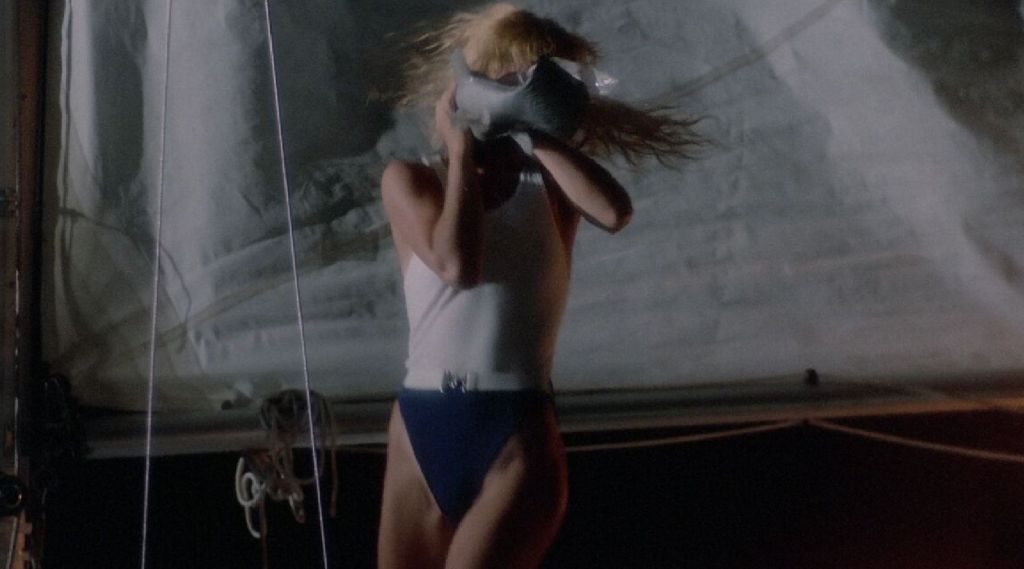
9. Piranha II: The Spawning (1982)
James Cameron famously worked as a special effects designer and artist for legendary B-movie producer Roger Corman when he landed his first gig as a director for this sequel to the 1978 cult classic Piranha. But according to multiple reports and Cameron himself (in an archived Los Angeles Times interview), he was fired after two and a half weeks by Italian producer Ovidio G. Assonitis, who took over the project himself. As a result, Cameron leaves the film off his resume, telling the Times, “I did some directing on the film, but I don’t feel it was my first movie.”
As a result, it’s hard to gauge Piranha II—one of those legendarily bad movies, with a six percent rating on Rotten Tomatoes and an infamous plot point in which the title creatures fly—in the larger context of Cameron’s later work. But the experience, along with his toiling in the Corman movie factory, certainly provided him with the kind of hands-on education that any aspiring filmmaker would probably benefit from. In the end, Piranha II is as significant in its own way as the rest of Cameron’s output: It got him his first credit as a director and was a crucial stepping stone to his first real movie. But more on that in a bit.
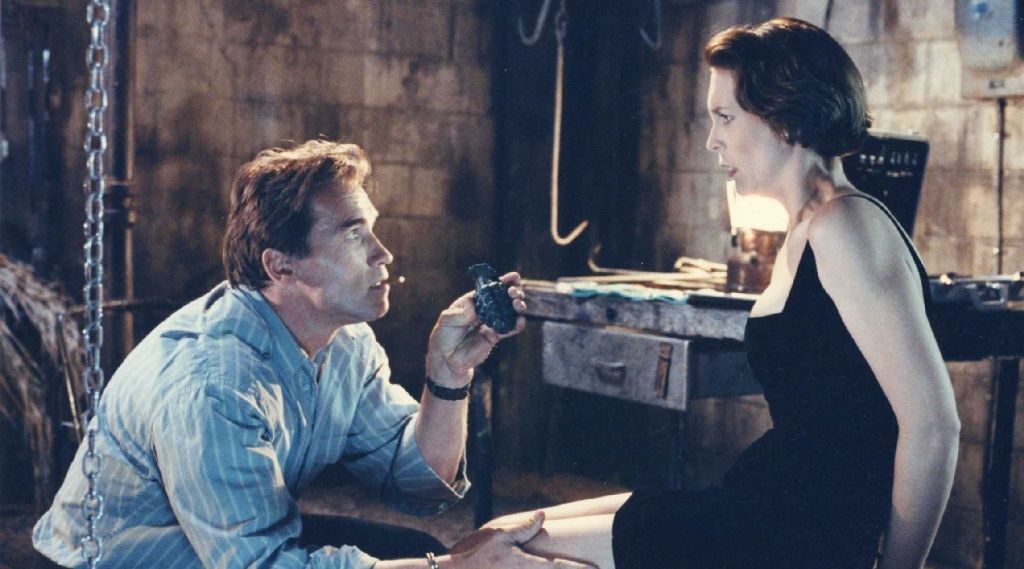
8. True Lies (1994)
After scoring a huge blockbuster with 1991’s Terminator 2: Judgment Day, Cameron turned to the spy genre with this loose remake of the 1991 French comedy, La Totale!, in which an international spy pretends to be a normal businessman while hiding his true career from his family. In Cameron’s version, Arnold Schwarzenegger (in his third collaboration with the director) plays Harry Tasker, who poses as a computer salesman to his wife Helen (Jamie Lee Curtis) and daughter Dana (Eliza Dushku) while embarking on globetrotting missions to defeat violent terrorists.
Without the sci-fi trappings that often elevate his movies, True Lies is a compendium of Cameron’s flaws as a filmmaker: it’s loud, its humor is boorish, its characters are thin, and its treatment of women and foreigners is sexist and xenophobic, respectively. Cameron’s generic Middle Eastern terrorists sparked a still-ongoing debate about the portrayal of Arabs and Muslims by Hollywood while Harry’s own deception and treatment of his wife (culminating in her being forced to perform a striptease for him without knowing it’s her husband) was slammed by critics as misogynistic.
The action, the special effects, and the cast’s commitment are all top-notch, so the film is not without considerable pulp entertainment value (and it was a major hit, although a proposed sequel never came to fruition). Yet in our view, it remains the “least” of Cameron’s big movies, lacking the vision that has propelled many of the others.
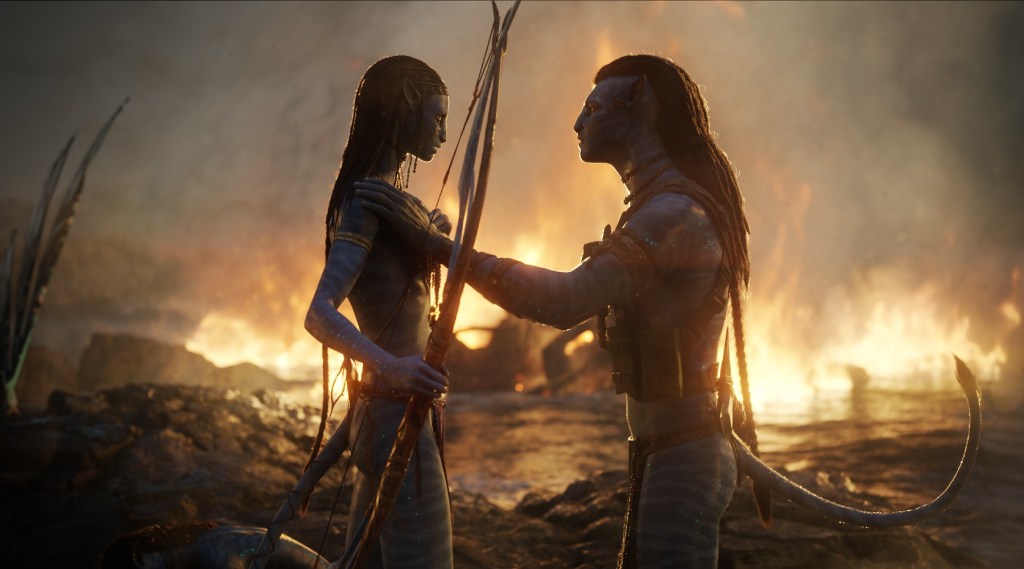
7. Avatar: The Way of Water (2022)
It’s difficult to rank this one as it’s so fresh out of the gate, and it could well move up or down in the standings as time goes by. But for the moment, The Way of Water, despite some of the most stunning CG work in all of film history, and a commitment to world-building that borders on the obsessive, lands pretty low on the list thanks to its lack of a compelling story or characters.
The Way of Water doesn’t even have the narrative momentum of its highly derivative predecessor. The first hour of the movie is a lot of haphazard set-up that seems to have whole elements of the plot papered over while the second is an increasingly dull montage of one visual effects set piece after another. Finally, the third hour piles on all that classic Cameron action to a crescendo of sound and visual pyrotechnics, leaving us less with a satisfying finale than the impression that this is all supposed to lead to something else.
The 48 frames-per-second film technique that Cameron has embraced, like Peter Jackson and Ang Lee before him, also turns into a distraction from the other genuinely wondrous visual work done here. Having said all that, anyone with a passing interest should absolutely see this on a big screen with all the bells and whistles; it deserves that much for now.
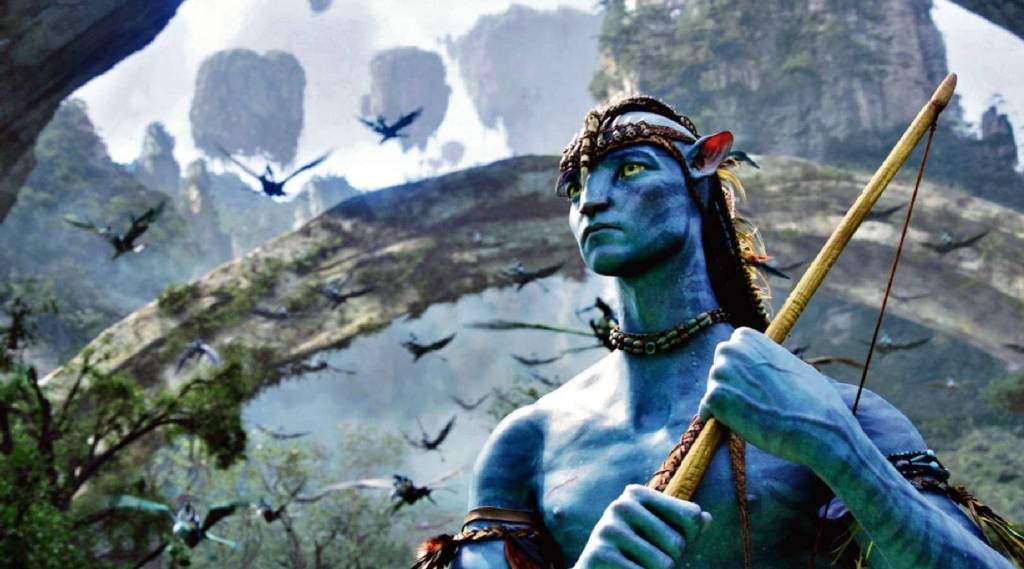
6. Avatar (2009)
Make no mistake: Avatar is one of the few films that deserved the label “game-changer” in terms of its groundbreaking visual effects and remarkably immersive use of 3D, a technique that had been almost entirely relegated to the dustbin of film history as a gimmick. Cameron’s jaw-dropping creation of the alien world of Pandora and its inhabitants was utterly unique and detailed beyond anything in the same vein done before or since.
But where Avatar fails, like its sequel, is in the story and characters, which shamelessly derive from Pocahontas, Dances with Wolves, and any other well-worn tales about a white savior arriving to rescue the indigenous primitives from the encroachment of his technologically advanced people. While in a sense that message, and Cameron’s concurrent environmental themes, are even more relevant now in a world that corporations are doing their best to pave over, his approach is heavy-handed and his characters, led by a wooden Sam Worthington and a cartoonish Stephen Lang, aren’t up to the task.
Still, there are moments and ideas that shine. For example, we wish he would further explore the idea that Pandora itself is a living, intelligent being; and the scope of the filmmaking and action is often breathtaking. And while small screen viewings of the film are more punishing visually (it has not aged well on TV), the recent remastered re-release proved to be a far more affecting viewing for us than the first time around.
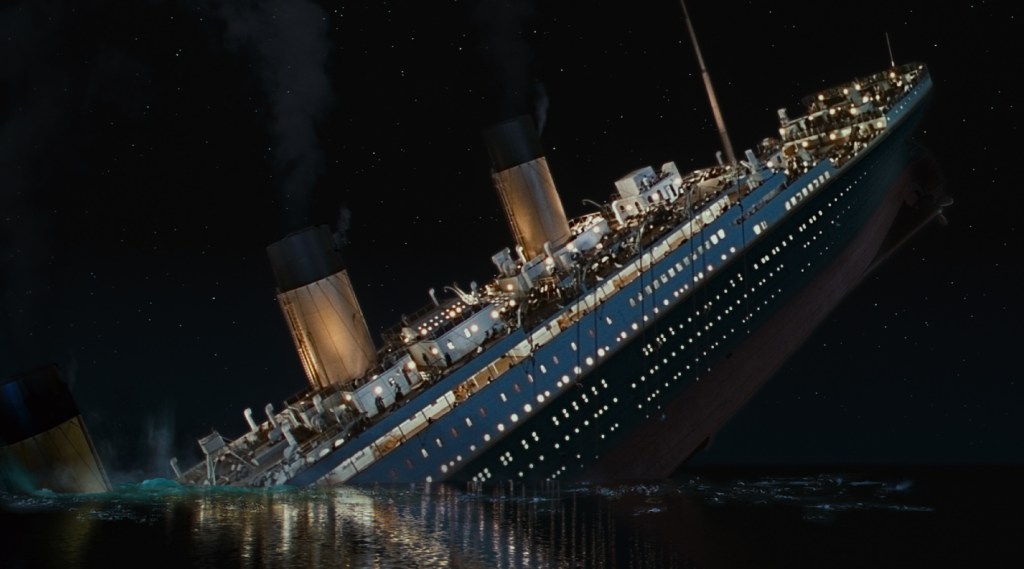
5. Titanic (1997)
We kind of wish we could split the first 90 minutes and the second 90 minutes (roughly speaking) of Titanic apart, since Cameron’s historical epic suffers from the cinematic version of dissociative personality disorder. On one hand, his detailed recreation of the unspeakably tragic 1912 sinking of the supposedly “unsinkable” RMS Titanic is filled with one sequence of excruciating tension and horror after another, as the ship’s different classes of people meet their fates in often unimaginably sad terms.
On the other hand, it does take more than an hour for the iceberg to even meet the ship’s haul, leaving us with a wholly fictional romantic piffle between Kate Winslet and Leonardo DiCaprio, with her privileged maiden and his lower-decks rascal falling in love despite her expected betrothal to a mustache-twirling Billy Zane. Even though both Winslet and DiCaprio (in star-making turns) are engaging, this weak-tea Romeo and Juliet storyline is not.
Once the ship’s destiny is sealed, however, Titanic becomes incredibly gripping, and one even buys into Leo’s abrupt pivot from poor artist into (albeit doomed) action hero. Cameron’s direction of the film’s second half is impeccable, the visual effects seamless and astonishing, and the old-fashioned studio gloss of the whole thing becomes a part of its grandeur. Even the love story becomes more moving in the context of the chaos and cataclysm around the star-crossed lovers.
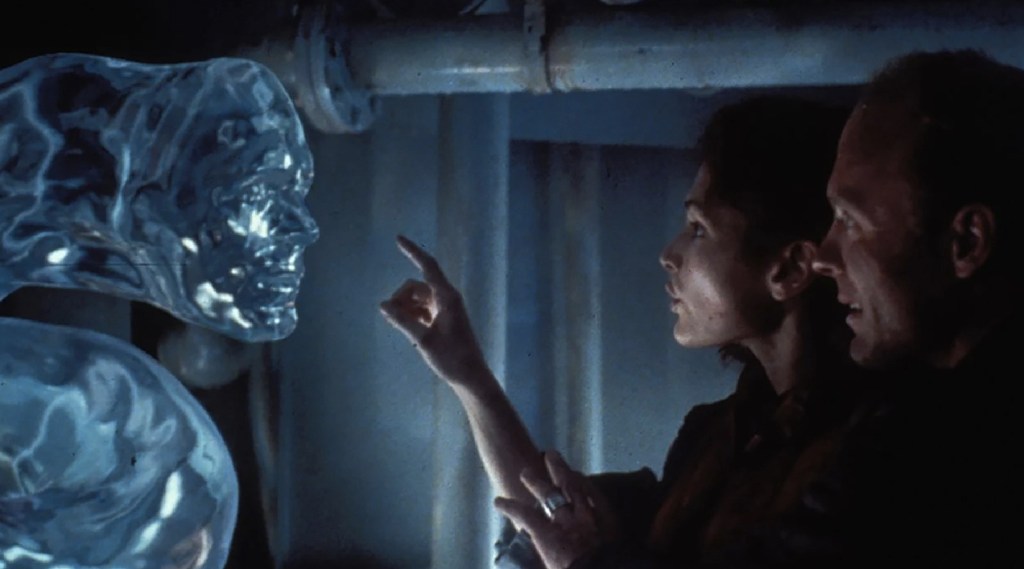
4. The Abyss (1989)
The Abyss was initially seen as the first stumble in Cameron’s career, and perhaps deservedly so. It wasn’t a hit at the box office, earning just under $90 million worldwide (and with a budget that was either around $45 million or $70 million, depending on the source). Critics weren’t super impressed either, although the reviews at the time were not resoundingly negative either. Most reviewers saw the movie, an underwater adventure in which the crew of a deep sea drilling platform and a team of Navy SEAL divers (led by a psychotic Michael Biehn) try to determine what caused a nuclear sub to sink in a deep undersea trench, as a solid high-tech thriller with a baffling, out-of-nowhere ending involving a massive alien craft.
But that’s because most critics saw the theatrical cut of the film, for which Cameron was forced by 20th Century Fox to remove 28 minutes of the movie, including a pivotal sequence near the end in which the aliens residing in the trench threaten to wipe out humanity if it doesn’t stop trying to destroy itself. While we remember enjoying the original cut as a gripping, suspenseful ride with great effects and performances (despite the usual Cameron archetypes subbing for real characters), the “special edition” is far better, giving more depth to the movie’s themes, the alien presence, and many of the characters.
The Abyss is one of Cameron’s more personal films, and also one of his most revolutionary: It marked the first time that the director worked with CGI, here to create an alien pseudopod and (for the special edition) a tremendous tidal wave. This portent of things to come is just one of the many reasons why The Abyss, a misunderstood and later embraced film, ranks just below Cameron’s holy trinity.
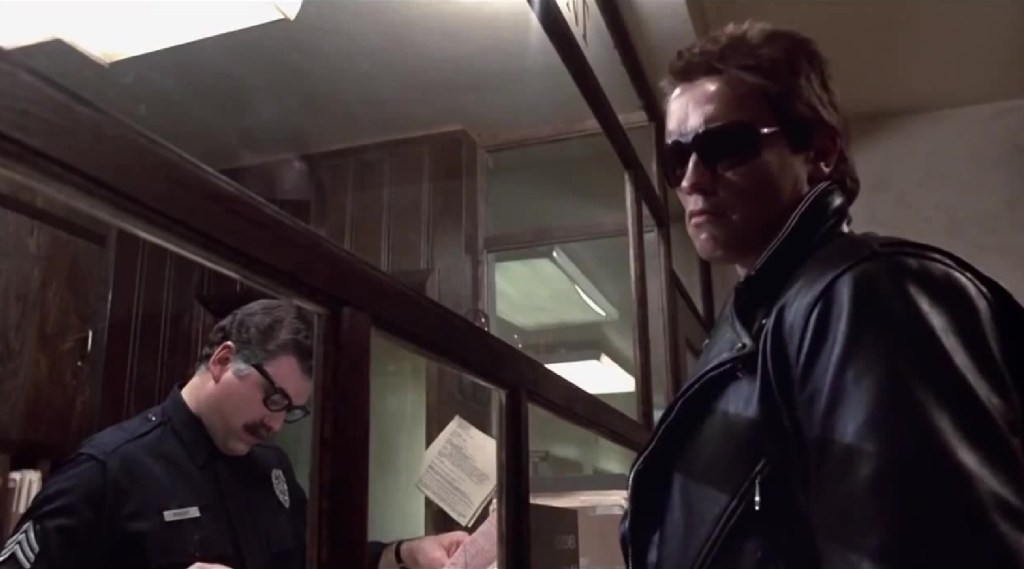
3. The Terminator (1984)
This is really where it all started for Cameron, with his second official directing gig (but the first that was really all his) and a movie that became not only one of the signature action/sci-fi thrillers of the 1980s but a classic of its genre. Several of the director’s early themes and stylistic trademarks—humanity vs. technology, relentless pacing and action, visceral violence—manifest themselves in this simple tale of a cybernetic assassin from the future sent back in time to kill the mother of humanity’s future savior.
The movie also began Cameron’s longstanding collaborations with Lance Henriksen, Michael Biehn, and of course Arnold Schwarzenegger, who was struggling to establish himself as an actor when this film came along and made him a star. And while Linda Hamilton’s role was more or less a damsel in distress for much of this movie, her character’s later evolution, combined with Cameron’s next movie, embraced the idea of women as action heroes long before Hollywood as a whole was willing to do so.
The Terminator also launched Cameron’s sometimes derivative approach to storytelling, as he was actually threatened with a lawsuit by legendary sci-fi writer Harlan Ellison for lifting elements from his Outer Limits episode “Soldier” (the case was settled out of court). But hey, everyone borrows from somewhere. Whatever its genesis, The Terminator remains a lean, tense, suspenseful, and even terrifying thriller with perfect casting, ingenious low-budget filmmaking, and a directorial energy that would be not be denied.
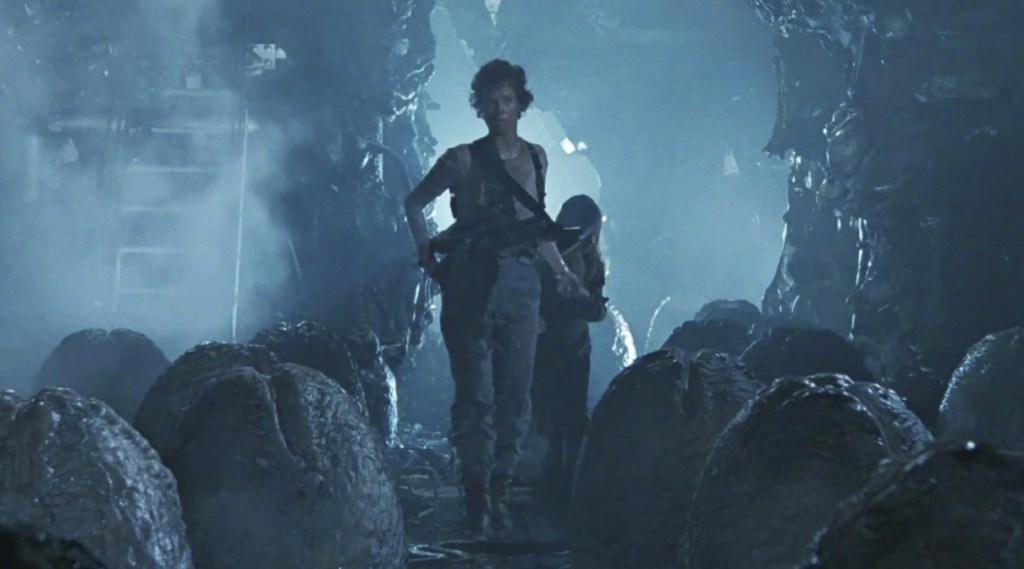
2. Aliens (1986)
It’s difficult enough to make a sequel to an acknowledged masterpiece, yet James Cameron, incredibly, did it twice. In this first instance—his first film for a major Hollywood studio (Fox)—he did it by flipping genres entirely. Largely discarding the haunted house and horror trappings of Ridley Scott’s original Alien (1979), Cameron instead turned the follow-up into a rousing “Marines vs. the monsters” story, featuring the kind of ragtag collection of charismatic soldiers seen and beloved in traditional war movies.
Leading the charge was Sigourney Weaver, the only survivor of Alien, returning to ger breakout role of Ripley and (at least temporarily) shattering the Hollywood taboo against female action heroes with a performance that remains one of the few in science fiction to be nominated for an Oscar. She was also surrounded by one of Cameron’s best casts. Even though his space Marines were archetypes instead of characters, folks like the unforgettable Bill Paxton, Michael Biehn, Jenette Goldstein, and Al Williams imbued them with personality, humanity, and humor.
Working with a relatively slim $18 million budget, Cameron crafted a breathless, intense, and oddly intimate story of terror, heroism, and battle that became one of the greatest sci-fi blockbusters of all time. While we prefer the leaner theatrical cut to the extended edition, we do wish that Cameron had kept the scene where Ripley learns about the fate of her daughter in the former; it provides a motivation to her later rescue of little alien attack survivor Newt (Carrie Henn) that adds an entire layer of thematic and emotional resonance to the movie.
Nevertheless, Aliens is a near-perfect film, and while the debate still rages over whether it’s better than its predecessor, its place in cinema history is secure.
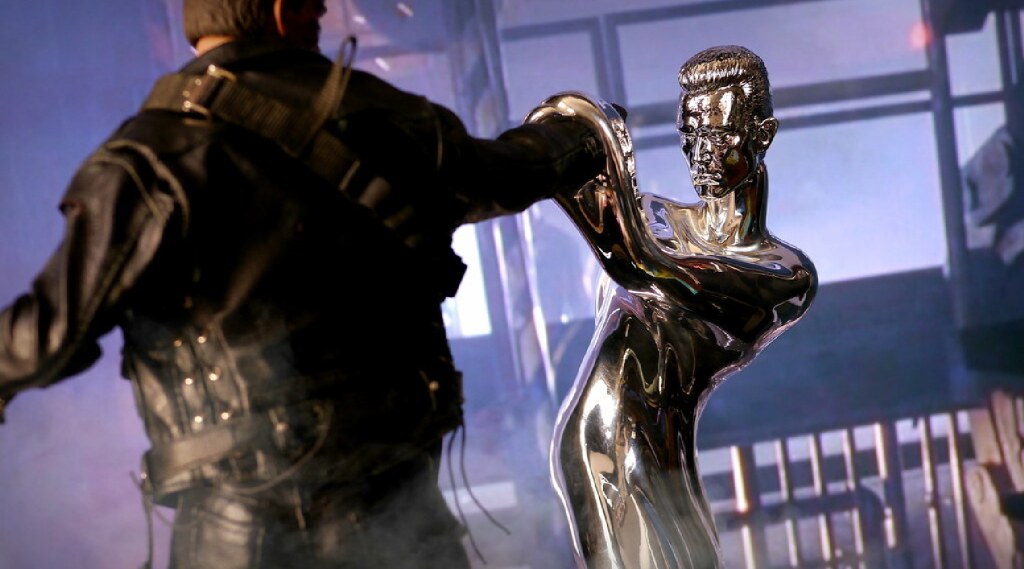
1. Terminator 2: Judgment Day (1991)
We wrestled with whether this or Aliens is Cameron’s best film, and in the end we decided to go with the movie that was still based wholly on his own vision rather than a sequel to someone else’s work (which doesn’t minimize Aliens in the slightest). Terminator 2 has been accused of just being a bigger, louder remake of the original, but it’s not. Instead it’s an expansion of the first film’s ideas and scope, with Cameron working with the kind of budget that allowed him to fully realize his vision (if arguably pushing the standards of epic filmmaking too high in the bargain).
Turning the villain of the original movie into the hero is a brilliant idea, with Schwarzenegger still playing to his strengths as the emotionless T-800 cyborg who eventually develops a modicum of human feelings through his father/son relationship with the future savior he’s sworn to protect, John Connor (Edward Furlong). The latter is a whiny brat of a kid and not some noble teen messiah in the slightest, also playing against type, while his mom Sarah (Linda Hamilton) balances conspiracy theorist paranoia, motherly love, and badass action moves in one of Cameron’s most unique heroines.
Then, of course, there is the T-1000 (Robert Patrick in his own breakout role), the liquid metal shapeshifter sent back to kill John Connor, whose lithe frame seems no match for big, bad Arnold but instead proves to be even more implacable and frightening than the original movie’s Terminator. The use of CG to create large sections of the character’s onscreen appearance was and is a breakthrough in film history, one that Steven Spielberg built on just two years later with Jurassic Park. The advancement of the technology in both films changed the course of cinema for better or worse, but 30 years later remains undeniably effective.
With its groundbreaking effects, a dazzling string of chases and action set pieces, some of the best character work Cameron and his actors have ever done, and a story so satisfying and complete that the Terminator franchise has long labored unsuccessfully to follow it up (even Cameron himself couldn’t get the job done on Terminator: Dark Fate, which he actively took a hand in developing), Terminator 2: Judgment Day remains a perfect fusion of all those elements and Cameron at the peak of his powers.
Avatar: The Way of Water is in theaters now.
